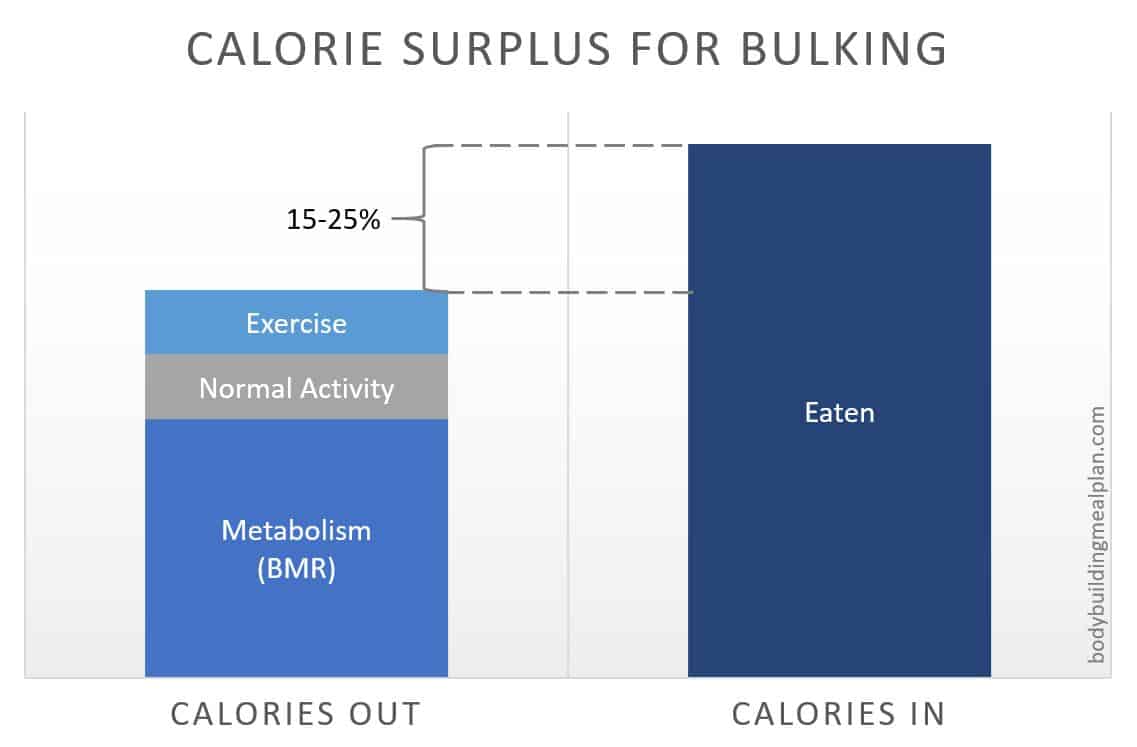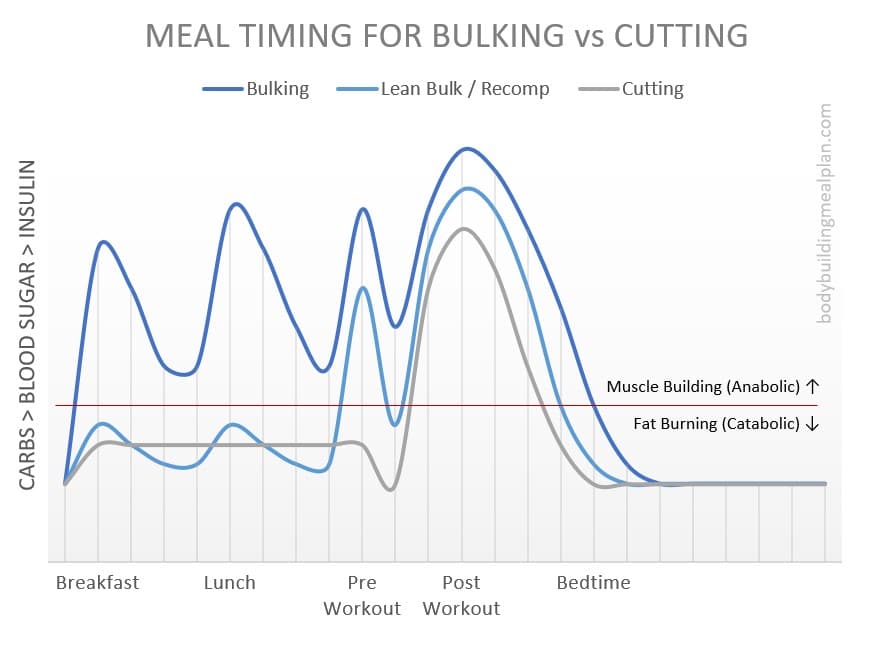
I’m sure you know that building muscle mass isn’t as easy as lifting heavy and eating whatever you want. It requires a strategic bulking meal plan designed to fuel your body while helping you recover and grow.
I’m here to provide you with a detailed program to help you pack on lean muscle mass. All you need to do is train hard and eat according to the diet plan. It’s so simple and effective that even hard gainers can grow!
To achieve the best results, bodybuilders follow a two-phase approach: bulking and cutting. The reason behind this is that the most significant transformations occur when you concentrate on either muscle gain or fat loss, not both.
Attempting to gain muscle and lose fat simultaneously (body recomposition) leads to slow and unimpressive progress for most people. And, let’s face it, you don’t want to wait years to reach your fitness goals. Therefore, bulking is the ideal option for those who want to gain muscle and strength quickly.
A bulking meal plan is a diet and workout program focused on muscle growth. The primary objective is to add as much muscle as possible while recognizing that body fat will also increase. However, lean bulking, which involves a slightly smaller caloric surplus, can prevent unwanted or excessive fat gain.
This strategy allows you to make the most significant gains possible by aligning your nutrition and training. So, if you are looking for a dramatic before-and-after picture, this plan is the one for you.

Next, I’ll explain the basic concepts behind my five-part nutrition strategy that helps you pack on muscle efficiently.
To successfully bulk up and gain muscle, you need to be in a calorie surplus. This means that you should consume more calories than you burn. However, it’s important to note that you can’t just eat as much as you want, or you’ll gain fat.
To start, you need to determine your total daily energy expenditure (TDEE) by calculating how many calories you burn through your metabolism, daily activities, and exercise. Once you know your TDEE, you can figure out the right calorie intake to maximize muscle growth while avoiding excess fat.
For most people, the ideal calorie intake is 15-25% more than their TDEE. If you’re looking to lean bulk, aim for a 5-15% surplus.
For example, Tony is a 180-pound guy with 20% body fat. He lifts weights five days per week but has a desk job and doesn’t get much activity outside the gym. Based on this information, Tony burns about 2,750 calories on days he works out, so he should eat around 3,160 to gain muscle (15% surplus).

It’s common knowledge that getting enough protein is essential for gaining muscle.
However, the rule of thumb to consume one gram of protein per pound of body weight is too simplistic. This rule can lead to an overweight person consuming too much protein, while a skinny hard gainer would not be consuming enough.
For this reason, I recommend determining your protein intake based on a percentage of your calories. Since your calorie intake was calculated based on your lean mass, this approach ensures that you get the right amount of protein based on your body composition.
Moving on to carbohydrates, a high-carb diet is beneficial for intense workouts and muscle growth. However, overconsumption of carbs can lead to extra calories being stored as fat. To avoid this, your carb intake should also be determined as a percentage of your calorie intake.
Finally, your fat intake makes up the balance of calories remaining. Your ideal macronutrient ratio depends on your activity and preferences, but here are some general ranges.
Macronutrient Ratios for Bulking:
Protein and carbs have 4 calories per gram, while fat has 9 calories per gram. Knowing this, we can determine how many grams of protein, carbs, and fat to eat each day.
Continuing our example, Tony is targeting 3,160 calories for bulking and wants to aim for 30% protein, 50% carbs, and 20% fat. That’s 237 g of protein, 395 g of carbs, and 70 g of fat.

When it comes to weight gain, healthy food choices play a crucial role in determining the effectiveness of your efforts. Eating a balanced diet of nutrient-dense foods is the best way to hit your calorie target and provide you with the necessary fuel for your workouts and recovery.
It may be tempting to fill your calories with tasty treats or junk food, but ultra-processed foods are not good for your body or health in the long run. For more details, check out my complete guide on dirty bulking vs. clean bulking.
High-density foods are rich in calories, vitamins, and minerals per serving, making them an excellent choice for bulking. While healthy fats are the most calorie-dense foods per gram, you should also consume foods high in protein and carbs to achieve your bulking goals.
Best Foods for a Bulking Diet:

Once you have calorie needs, macro ratios, and food choices dialed in, nutrient timing is the final piece of the bulking meal plan puzzle. Meal frequency plays a significant role in your body’s physiological state.
Specifically, consuming food, particularly carbohydrates, puts your body in an anabolic state conducive to building muscle. On the other hand, fasting or eating low-carb meals can result in a catabolic state and the breakdown of muscle tissue.
The chart below shows how timing your meals can help you maintain a muscle-building state throughout the day. This is especially true after an intense weight training workout, which is commonly referred to as the anabolic window.

A balanced diet filled with quality foods is the foundation of a bulking meal plan. Only after you have laid the foundation should you use dietary supplements to fill in the cracks.
Mass gainers are one of the go-to supplements for hard gainers, and I fell into the trap in my youth as well. However, these powders are nothing more than whey protein mixed with maltodextrin (sugar). So you should not resort to using them unless you have a really hard time eating enough whole food.
Here is my list of the top bodybuilding supplements that are proven effective for building muscle.

At this point, you might be feeling a little information overload. So it’s easiest to jump into some examples showing you s real-life bulking meal plan example.
I created the following daily meal plans using the calorie and macro targets we calculated earlier. Your meals and quantities will vary depending on your body size, workout routine, and daily activity.
On days you work out, this meal plan consists of six meals, including pre and post-workout. I’ve provided three recipe options for each meal from which you can choose.
This plan is set up for someone who works out in the evening, but you can rearrange the meals to fit your schedule.
If the dinner meal is too large to eat in one sitting, you can split it up into two meals. Here’s a 1-minute video showing you how to make the protein oatmeal recipe.